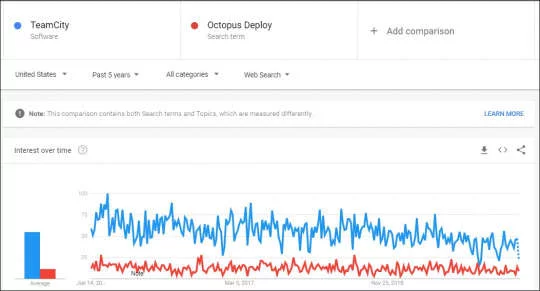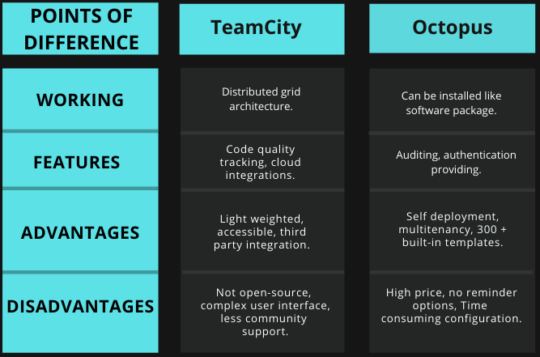Saving on time is also one of the strengths of a successful business.
Automation was introduced in the first place to overcome the time-consuming business operations.
TeamCity and Octopus (Octopus Deploy) are two such tools that are well suited for automation purposes.
TeamCity helps in simplifying build automation, where Octopus Deploy eases the deployment automation process.
Exploring the Difference between TeamCity and Octopus Deploy
From the search results, it is quite visible that TeamCity is preferred much more when it comes to the customer choice of opting for deployment automation.
TeamCity’s architecture is based on distributed build grid architecture.
The software that executes the build process is termed a build agent.
Since the software has to be tested on different platforms and conditions, TeamCity’s build agents help them to do so as they have different platforms and operating systems.
This, thus helps the developers to receive quick feedback.
The server of TeamCity helps in the examination of connected build agents.
It also passes on the builds to the agents according to the compatibility requirements.
Octopus Deploy is basically a software package that a user can download and install on servers.
Users, along with Octopus deploy server, have to install a Tentacle agent for the machines on which the deployment is to be done.
One Octopus server can control multiple tentacles.
Octopus assists more specifically in the deployment process for Windows Azure, cloud service, FTP, or FTP servers.
Developers inspect their code into source control systems and build servers. Then they compile the code and tests it.
After the build is done, the build server collects the files, which include binaries, images, etc. into packages.
Octopus then pushes these packages to the machines that they are going to be deployed on.
From here, it’s the user that defines the environment process for the deployment of software.
The Octopus dashboard hereafter provides the teams to queue deployments for a specific environment. For example, a tester can deploy application only in a test environment and not others.
This means that the deployment process is still consistent, even if multiple deployments from multiple teams happen.
Also Read: Jenkins vs. Docker: What’s the Difference?
Code Quality Tracking
Duplicate code fragments can be taken care of with the help of tools like IntelliJ IDEA and ReSharper.
Users can also download recent inspections results.
Automatic Assigning of Investigations
TeamCity has the ability through its self-learning to notify team members about investigations regarding the build failures.
Cloud Integrations
TeamCity integrates with cloud platforms like Microsoft Azure, Google Cloud, Vmware, and Kubernetes.
Platform supported
TeamCity supports platforms like Java, .NET, and Ruby.
Let’s take a look at some of the key features of Octopus Deploy
Deployment automation
Helps in the automation of releasing the applications for desktop, web, and mobile access.
Auditing
Octopus captures the following while auditing:
- Any changes to deployment processes.
- Cancelling of deployments.
Authentication Providing
For Teams
Role-based permission to have control over what they do.
Auto Login
Users can configure or Log into Octopus by following the below procedures:
Firstly, the user should click a button on the Octopus login screen.
Secondly, sign in the user automatically by redirecting to an external identity provider.
Process Analytics
Informs and evaluates process efficacy by delivering information related to time and cost.
Below mentioned are some of the advantages of TeamCity:
-
- Checks the status of builds across many projects.
- The availability of multiple plugins makes integration with other platforms quite easy.
- Test the changes without being dependent on Version Control Systems (VCS).
- TeamCity allows integration of third party reports if the outputs are HTML based.
- It is quite light weighted and is accessible.
Let’s discuss some of the advantages of Octopus Deploy
-
- Promotes self-service deployment, which means anyone from the team can deploy the release.
- Its self-explanatory dashboard helps viewers to understand what version of the application is under production easily. In short, it assists users in knowing what’s deployed where.
- Allows multitenancy.
- No scripting is needed as Octopus automatically replaces values in configuration files.
- Deploys just anything with the help of 300 + built-in templates.
Below mentioned are some of the disadvantages of TeamCity
-
- It is not open-source.
- Need for the license after 3 agents and 100 builds.
- Lesser community support.
- Complex user interface for new users.
- Upgrading to another version is quite tedious.
Let’s discuss some of the reviews of Octopus Deploy
-
- Quite high prices ranging between $39,000 for 500 targets to $138,000 for 2,000 targets.
- Configuring Octopus deploy is a bit time-consuming.
- Pipeline configuration is complex while configuring deployments in multiple environments.
- Lacks in integration for management tools like JIRA and HP.
- Absence of reminder options for pending approvals.
Conclusion
Both of the tools are quite superior in terms of their functionalities.
However, TeamCity seems to be taking the limelight away from octopus as it’s more advanced with its features wherein it is able to handle multiple deployments systematically and in an orderly manner.
Also Read: Nanoservices vs. Microservices: How do they Differ?






